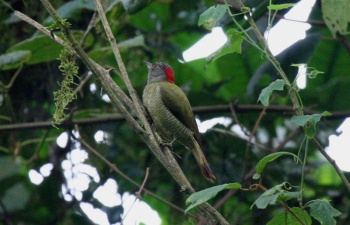- Campethera taeniolaema
Identification
18–20 cm (7-7¾ in)
Male
- Forecrown to nape red, sometimes mottled blackish on front half
- Face and throat grey, usually with fine blackish barring and with black mark in front of eye
- Upperside olive-green
- Lesser coverts tipped red forms red mark on folded wing
- Underparts yellow-green with darker barring of dark olive
Female
- Similar to male but front half of crown black with small white spots, rear end red
Immature
- Duller above
- More heavily barred below.
Similar Species
Other species with green upperparts should be found mainly at lower elevation than this species and have different facial pattern.
Distribution

Photo © by megan perkins
Castle Forest Lodge, Mt Kenya, Kenya, 14 December 2006
Eastern Africa: Burundi, Rwanda, eastern Democratic Republic of Congo,Uganda, Kenya, Tanzania
Taxonomy
Fine-banded Woodpecker was formerly included in Tullberg's Woodpecker.
Subspecies
Clements recognizes these subspecies[1]:
- C. t. taeniolaema: Face and underparts greenish with narrow barring
- C. t. hausburgi: As above but face and underparts yellowish
- Highlands of Kenya (east of Rift Valley) and extreme northern Tanzania
Habitat
Moist montane forest between 900 and 3000 m (rarest below 1500 m), generally using ravines and edges, and may visit nearby lone, dead trees.
Behaviour
Presumably eats small invertebrates such as ants. Mostly uses probing into softer material such as epiphytes and dead wood.
Breeding
They excavate a hole in a tree for the nest.
Vocalisation
Call not recorded. Usually silent. Reported to give a loud kweek-kweek-kweek
References
- Clements, J. F., P. C. Rasmussen, T. S. Schulenberg, M. J. Iliff, T. A. Fredericks, J. A. Gerbracht, D. Lepage, A. Spencer, S. M. Billerman, B. L. Sullivan, and C. L. Wood. 2023. The eBird/Clements checklist of Birds of the World: v2023. Downloaded from https://www.birds.cornell.edu/clementschecklist/download/
- Gill, F, D Donsker, and P Rasmussen (Eds). 2023. IOC World Bird List (v 13.2). Doi 10.14344/IOC.ML.13.2. http://www.worldbirdnames.org/
- Kirwan, G. M., H. Winkler, and D. A. Christie (2023). Fine-banded Woodpecker (Campethera taeniolaema), version 1.0. In Birds of the World (B. K. Keeney and N. D. Sly, Editors). Cornell Lab of Ornithology, Ithaca, NY, USA. https://doi.org/10.2173/bow.tulwoo3.01
Recommended Citation
- BirdForum Opus contributors. (2025) Fine-banded Woodpecker. In: BirdForum, the forum for wild birds and birding. Retrieved 12 May 2025 from https://www.birdforum.net/opus/Fine-banded_Woodpecker
External Links
GSearch checked for 2020 platform.1




